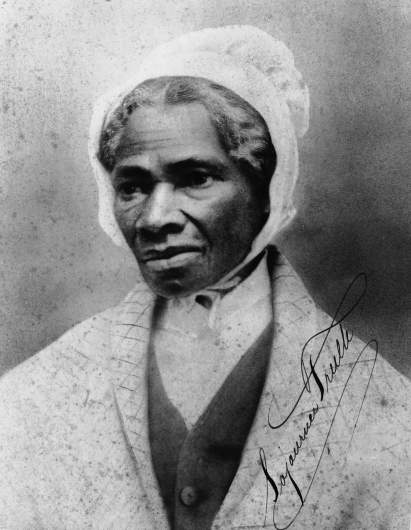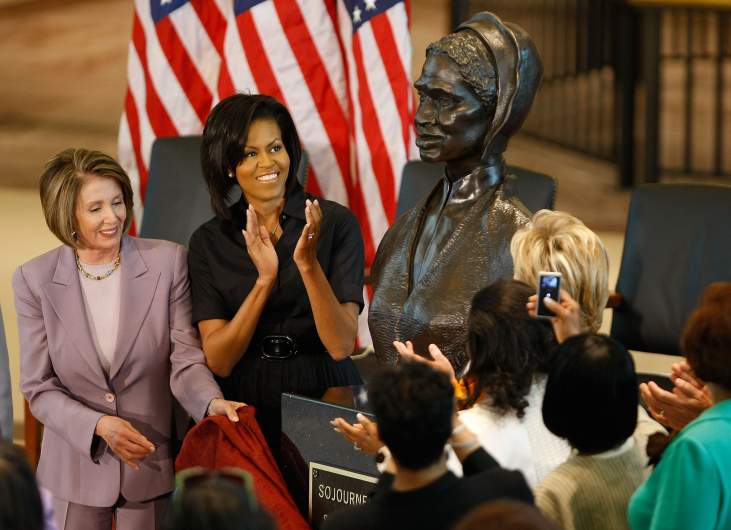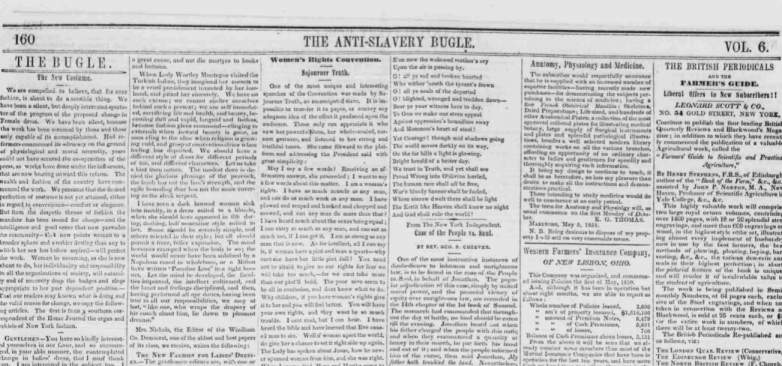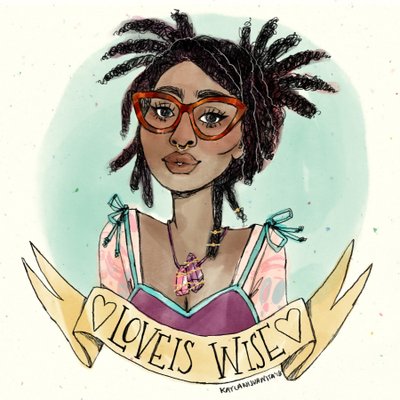
On the first day of Black History Month, Google has chosen Sojourner Truth as its Doodle.
As named by the Smithsonian, Truth is one of the 100 Most Significant Americans.
Born into slavery at the end of the 18th century, she’d be sold and sold again and have her children stolen from her and sold, too.
Truth told her story and was among the most influential of abolitionists. She was also a key figure in the women’s rights movement.
Here’s what you need to know:
1. Abolitionist Sojourner Truth Was Born Into Slavery, Not in the Deep South, But in Upstate New York

Portrait of American abolitionist and feminist Sojourner Truth (1797 – 1883), a former slave who advocated emancipation, c. 1880. (Photo by Hulton Archive/Getty Images)
Born to parents James and Elizabeth Baumfree in 1797, one of 10 children in the family of slaves in Swartkill, Ulster County in upstate New York. The family was owned by a Dutch slaveowner named Hardenbergh. She was named Isabella at birth. Isabella, or Belle as she was called, was sold and bought several times in her young life and witnessed the same for her sisters and brothers and ultimately, her own children. When she was just 9, she was first sold at an auction with a flock of sheep for $100 to John Neely who she would later describe as cruel and who beat her regularly. Two years after, she was sold again for $105. And then a year later, she was sold again. She spoke only Dutch as her owners were all Dutch, as was much of the population in New York.

Portrait of African-American orator and civil rights activist Sojourner Truth (1797 – 1883), 1860s. (Photo by Hulton Archive/Getty Images)
Though she fell in love with a slave in a nearby farm in 1815, the romance was forbidden and he was beaten. He died a few years after. She soon married another slave and gave birth, at least one of the pregnancies was the result of rape. Her child Sophia was born in 1826.
In 1799, New York passed a Gradual Emancipation act that freed slave children born after July 4, 1799, but indentured them until they were young adults. In 1817 a new law passed that would free slaves born before 1799 but not until 1827.
According to the Library of Congress, in 1827, she escaped with her months-old baby Sophia to the safety of abolitionists Isaac and Maria Van Wagenen who purchased her freedom for $20. Soon after, she would, with the help of abolitionists, sue a white slave owner who had illegally sold her son Peter, 5, into slavery in Alabama. She took the white slaveowner to court and won; the first time a black woman successfully sued white people.
One of the Sojourner Truth quotes, “I feel safe in the midst of my enemies, for the truth is all power and will prevail,” helped fuel her determination.
2. Former Slave Belle Baumfree Becomes Sojourner Truth
She moved to New York City in 1828 and, while working for a preacher, said she was called to do the same: preach the truth. Former slave Isabella ‘Belle” Baumfree became Sojourner Truth. While there she met abolitionists William Lloyd Garrison and Frederick Douglass, the latter said she should write about her experiences and “speak out against the evils of slavery.”
Truth had never learned to read or write. In 1850, she spoke her story, ‘The Narrative of Sojourner Truth,’ which soon was a nationally recognized work. And she’d become a women’s rights activist advocating for racial and gender equality. Her speech ‘Ain’t I a Woman’ is a testament to both.
During the Civil War, she recruited black men to serve in the Union Army. Following the war, she attempted to secure land grants from the federal government for former slaves, the so-called Forty acres and a mule promise. She was unsuccessful. She was successful however in resettling freed slaves and thereby settling Battle Creek, Michigan. She died there of old age in 1883.
In 2009, a bust of Sojourner Truth was unveiled in the U.S. Capitol Visitors Center.

Speaker of the House Nancy Pelosi (D-CA), (L) and first lady Michelle Obama applaud after the unveiling of the bust of Sojourner Truth in the U.S. Capitol Visitors Center April 28, 2009 in Washington, DC. Sojourner Truth was a 19th-century American slave, abolitionist and womens’ rights activist who is best known for her speech, “Ain’t I a Woman?”
More recently, the US Treasury announced that Truth will be included on the new $10 bill, along with other suffragists. The new bill is expected to be revealed on the 100th anniversary of the 19th Amendment, which granted women the right to vote, in 2020.
3. Sojourner Truth’s ‘Ain’t I a Woman’ Speech From 1851

Delivered in 1851 at the Women’s Rights Convention, the speech, ‘Ain’t I A Woman?’ may be a version of Sojourner Truth’s writing.
First published by Frances Gage in 1863, 12 years after it was first delivered, the other version was published a month after the speech was delivered in the Anti-Slavery Bugle by Rev. Marius Robinson. This version does not include the specific title phrase ‘Ain’t I a Woman.’
Regardless, this is the speech as delivered 168 years ago:
“Well, children, where there is so much racket there must be something out of kilter. I think that ‘twixt the negroes of the South and the women at the North, all talking about rights, the white men will be in a fix pretty soon. But what’s all this here talking about?
That man over there says that women need to be helped into carriages, and lifted over ditches, and to have the best place everywhere. Nobody ever helps me into carriages, or over mud-puddles, or gives me any best place! And ain’t I a woman? Look at me! Look at my arm! I have ploughed and planted and gathered into barns, and no man could head me! And ain’t I a woman? I could work as much and eat as much as a man – when I could get it – and bear the lash as well! And ain’t I a woman? I have borne thirteen children and seen most all sold off to slavery, and when I cried out with my mother’s grief, none but Jesus heard me! And ain’t I a woman?
Then they talk about this thing in the head; what’s this they call it? [member of audience whispers, “intellect”] That’s it, honey. What’s that got to do with women’s rights or negroes’ rights? If my cup won’t hold but a pint and yours holds a quart, wouldn’t you be mean not to let me have my little half measure full?
Then that little man in black there, he says women can’t have as much rights as men, ’cause Christ wasn’t a woman! Where did your Christ come from? Where did your Christ come from? From God and a woman! Man had nothing to do with Him.
If the first woman God ever made was strong enough to turn the world upside down all alone, these women together ought to be able to turn it back, and get it right side up again! And now they is asking to do it, the men better let them.
Obliged to you for hearing me, and now old Sojourner ain’t got nothing more to say.”
When Truth was honored in 2009 in the Capitol, actor Cicely Tyson delivered ‘Ain’t I a Woman.’
4. Books & Films About Sojourner Truth Abound Including a Recent Emmy Award-Winning Animated Short
Filmmaker and Southwestern Adventist University professor Kyle Portbury’s short animated film about Sojourner Truth’s 1851 speech, ‘Ain’t I a Woman.’
“We are humbled to receive an EMMY® award for ‘Truth.’ Sojourner’s courage to speak up against injustice 167 years ago still resonates today. It’s sacrifices by people like Sojourner Truth that encourage us today to keep trying to do what is right, regardless of the consequences,” Portbury said of his work and the award.
5. Loveis Wise is the Illustrator Behind the Sojourner Truth Google Doodle. Google’s Oona King Explains the Importance of Celebrating Sojourner Truth

Loveis Wise Twitter
Quoted by Google, Wise said, “Without her work & the awareness Sojourner spread, the US would not be what it is today! It’s important to lift up her legacy & reflect on that.”
Loveis Wise is a freelance illustrator from Washington, DC, now based in Philadelphia. Her client list includes The New Yorker, The New York Times, Tampa Bay Times, Eileen Fisher, The Poetry Foundation, and Cartoon Network.
Loveis Wise has been getting a lot of love on Twitter.
“Thanks for the constant love and positive messages you all have been sending me today! Take some time to reflect on Sojourner’s history and BLACK history! Let’s make this world in her vision of freedom and equality?”
Oona King is Google’s Director of Diversity Strategy. She says the selection of Truth a the Google Doodle to celebrate the beginning of Black History Month is also reflective of the mission to have a “workforce reflective of all…”
“’Sojourn”’means to journey; to live somewhere temporarily. As slaves, African-Americans always ‘lived temporarily,’ never knowing when all family ties would be severed on the next auction block,” King says in the just-published Google blog post.
“Sojourner Truth taught us that ‘a journey’ can be much more than changing places. It can be about changing reality, changing fate. However you describe it, fundamentally it’s about making a previously unimagined change—and that’s what I’d like us to do at Google during Black History Month. If we want to build ‘products for all’ and make them ‘universally useful and accessible,’ then we need a workforce reflective of all, and a workplace free of prejudice and bias.”
